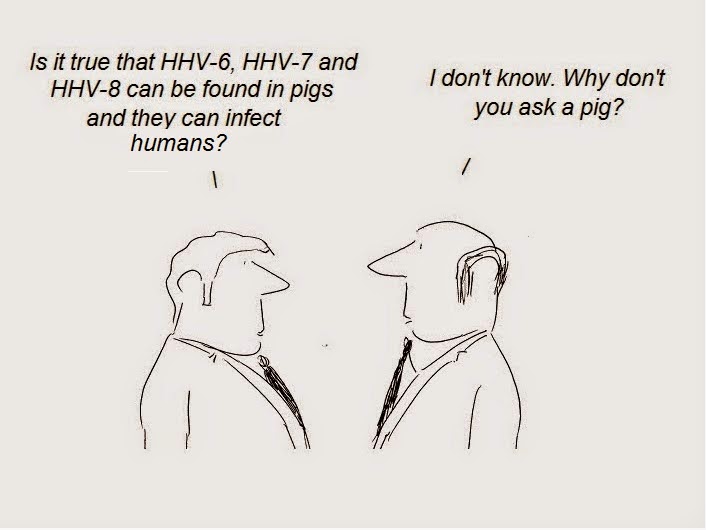In addition to "Long-haul AIDS," the correction of the CFS/AIDS paradigm may require the new working diagnosis of "Long-haul Kaposi's Sarcoma."
HHV-8 may hold the key to the real nature of the CFS/AIDS pandemic
The apoptosis cascade may be initiated by pathogenic agents such as viruses and is considered as part of the cellular defensive mechanism. Viruses have adapted numerous ways of circumventing this host defensive response, including regulation of endogenous host death receptors and ligands, expression of caspase activation inhibitors, regulation of host Bcl-2 proteins, and expression of viral homologues of Bcl-2 (vBcl-2s) (Benedict et al., 2002; Polster et al., 2004).These viral genes encoding proteins with amino acid sequence similarity to cellular Bcl-2 apoptosis inhibitors have been identified in several viral models including Epstein–Barr virus (EBV) (Bellows et al., 2002; Henderson et al., 1993), human herpes virus 8 (HHV8) (Cheng et al., 1997) and African swine fever virus (ASFV) (Afonso et al., 1996) between others. The role of these vBcl-2s in diverse aspects of the viral cell-cycle and their mechanism of action has been gradually emerging (Everett and McFadden, 1999; Hardwick and Bellows, 2003). VBcl-2s mediate inhibition of apoptosis in infected cells and prevent premature death of the host cell which would impair virus replication and might have also a role in the development of persistent infection (Cuconati and White, 2002).
High prevalence of antibodies to human herpesvirus 8 in relatives of patients with classic Kaposi's sarcoma from Sardinia
A survey for antibodies to a recombinant small viral capsid antigen (sVCA) of human herpesvirus type 8 (HHV-8) was conducted in Sardinia, one of the world's highest incidence areas for classic Kaposi's sarcoma (KS). Prevalence of antibodies to HHV-8 sVCA was greatest in patients with KS (95%), followed by family members (39%) and a Sardinian control population age- and sex-matched to the relatives (11%). Within families, prevalence of antibodies was about equal among spouses, children, and siblings of KS patients, a finding that raises the possibilities of intrafamilial person-to-person or vertical transmission. Antibodies were detected 2-3 times more frequently in males than in females. The data show that prevalence of antibodies to HHV-8 sVCA correlates with the distribution of classic KS in a high- incidence area. Clustering of seroprevalence within some families suggests the presence of familial risk factors for active HHV-8 infection.
Why is African swine fever still present in Sardinia?
Abstract
African swine fever (ASF) is an infectious disease of swine that has been present in Sardinia since 1978. Soon after introduction of the disease, several control and eradication programmes were established with limited success. Some researchers attributed the persistence of the disease in central and eastern areas to certain socio-economic factors, the existence of some local and traditional farming practices (i.e., unregistered free-ranging pigs known as brado animals) and the high density of wild boar in the region. In the past, scarcity of swine data in Sardinia complicated the evaluation and study of ASF on the island. More complete, accurate and reliable information on pig farms has become available as a result of the most recent eradication programmes. Here, we perform statistical modelling based on these data and the known distribution of domestic pig and wild boar to identify the main risk factors that have caused ASF persistence in Sardinia. Our results categorized, identified and quantified nine significant risk factors, six of which have not been previously described. The most significant factors were the number of medium-sized farms, the presence of brado animals and the combination of estimated wild boar density and mean altitude above sea level. Based on these factors, we identified regions in eastern and central Sardinia to be at greatest risk of ASF persistence; these regions are also where the disease has traditionally been endemic. Based on these risk factors, we propose specific control measures aimed at mitigating such risks and eradicating ASF from the island.
Why is African swine fever still present in Sardinia? - PubMed (nih.gov)
"The 19R Protein of HHV-6 has significant amino acid sequence homology . . . to a protein encoded by African Swine Fever Virus."
--Glenda L. Lawrence, John Nicholas and Bart G. Barrell
Journal of General Virology (1995), 76, 147-152
https://citeseerx.ist.psu.edu/viewdoc/download?doi=10.1.1.586.1046&rep=rep1&type=pdf
Another HHV-8- associated condition, the KSHV inflammatory cytokine syndrome (KICS), has been more recently described.48-50 Patients with this syndrome display MCD-like inflammatory symptoms, but do not have pathological findings of MCD. Patients with KICS are frequently critically ill and demonstrate marked elevations in IL-6 and IL-10, as well as high plasma HHV-8 viral loads. KICS may contribute to the inflammatory symptoms seen in some patients with severe KS or PEL, and there may be significant clinical overlap between these conditions. https://aidsinfo.nih.gov/guidelines/html/4/adult-and-adolescent-opportunistic-infection/342/hhv-8
Chronic Fatigue Syndrome patients may have undiagnosed internal Kaposi's Sarcoma.
Prevalence in the Cerebrospinal Fluid of the Following Infectious Agents in a Cohort of 12 CFS Subjects
Susan Levine
Published online: 04 Dec 2011
https://www.tandfonline.com/doi/abs/10.1300/J092v09n01_05
If HHV-8 (which seems to cause Castleman Disease) really is African Swine Fever then pigs will make an excellent model for studying Castleman Disease. Is this an indication that HHV-8 is really African Swine Fever Virus?
"Primary HHV-8 infection may be associated with fever and a maculopapular rash in immunocompetent children."
http://www.uptodate.com/contents/disease-associations-of-human-herpesvirus-8-infection
High prevalence of antibodies to human herpesvirus 8 in relatives of patients with classic Kaposi's sarcoma from Sardinia.
http://www.ncbi.nlm.nih.gov/pubmed/9607855
Infection with human herpesvirus type 8 and Kaposi's sarcoma in Sardinia.
http://www.ncbi.nlm.nih.gov/pubmed/16501902
Epidemiology of HHV8 in Sardinian emigrants
http://www.dsnm.univr.it/?ent=progetto&id=565
Both ASFV and HHV-8 Interfere with apoptosis.
Are ASFV-infected Pigs the viral source of HHV-8 related Kaposi's Sarcoma in Sardinia? Is a ASFV-related Kaposi's Sarcoma epidemic possible in Russia where ASFV is spreading?
https://hhv6.jottit.com/35._pigs_and_kaposi%27s_sarcoma_in_sardinia
The world's highest incidence of Kaposi's sarcoma occurs in Sardinia (Reference) Is it possible that it is due to the fact that African Swine Fever Virus is endemic on the island? (Reference) One study suggests that the incidence of K.S. in northern Sardinia is highest in a countryside area where people have contact with animals. (Reference) Given the high prevalence of HHV-8,--the so-called K.S. herpes virus--in Sardinia (Reference) is it at all possible that HHV-8 may have been misclassified and actually is a human-adapted form of African Swine Fever Virus? (ASFV has been at least visually mistaken for another herpes virus, CMV, in the past.)
A number of experiments could be conducted to explore this hypothesis. In addition to a direct comparison of ASFV and HHV-8, pigs with African Swine Fever Virus could be tested for sequences of HHV-8. People with Kaposi's sarcoma could be tested for sequences of African Swine Fever, including new Asfaviridae sequences recently discovered. (Reference)
A comparison of the K.S. lesions in humans and ASFV lesions in pigs might be in order.Given that African Swine Fever is currently spreading in Russia and is now threatening Europe and China, (Reference) it would be useful to know whether people who are exposed to pigs with ASFV are at increased risk for HHV-8, Kaposi's sarcoma and the other pathologies associated with HHV-8. A study in sub-Saharan Africa where ASFV is endemic and HHV-8 is also endemic (Reference) might be useful. And areas of Russia where ASFV is spreading could be monitored closely for any signs of an increase of K.S. or HHV-8 infection and HHV-8 related pathologies.HHV-8 is an emerging health problem. HHV-8-associated K.S. is a significant problem in AIDS patients. It may also be the key to Chronic Fatigue Syndrome. HHV-8 has been found in the cerebrospinal fluid of 50% of Chronic Fatigue Syndrome patients. (Reference) HHV-8 has been linked to type 2 diabetes. (Reference) HHV-8 has been detected in B-cells in Castleman's disease and primary effusion lymphoma. (Reference).
If HHV-8 is a form of ASFV, it is possible that pigs might constitute a useful animal model for the study of possible treatments for K.S. and other pathologies associated with HHV-8. And if there is any relationship between ASFV and HHV-8, people may have to be warned to take special precautions around pigs in areas where there are ASFV outbreaks. And countries where undercooked pork is consumed (like Ukraine where salo is a staple) may need to alert the public to cook all pork products thoroughly during ASFV epidemics.
York Native on the lesions in CFS patients which seem
to resemble Kaposi's Sarcoma (KS). The current
thinking is that a virus called HHV-8 is the cause of
KS. (Although HHV-6 has recently also been implicated
once again.) If KS is a problem in CFS (and we
suspect it is) then one should be able to find HHV-8 and
HHV-6 in CFS patients. Apparently, in this small
study, one can. Below is a rather explosive abstract:
infectious agents in a cohort of 12 CFS subjects:
human herpes virus-6 and 8; chlamydia species;
mycoplasma species; EBV; CMV; and Coxsackievirus.
Levine, S.
Journal of Chronic Fatigue Syndrome, 2001, 9, 1/2,
41-51.
Over the last decade a wide variety of infectious
agents have been associated with the CFS as potential
etiologies for this disorder. Many of these agents are
neurotrophic and have been linked previously to other
diseases involving the central nervous system (CNS).
Human herpes virus-6 (HHV-6), especially the B
variant, has been found in autopsy specimens of
patients who suffered from MS. Because patients with
CFS manifest a wide range of symptoms involving the
CNS as shown by abnormalities on brain MRIs, SPECT
scans of the brain and results of tilt table testing
we sought to determine the prevalence of HHV-6, HHV-8,
Epstein-Barr Virus (EBV), cytomegalovirus (CMV),
mycoplasma species, chlamydia species, and Coxsackie
virus in the spinal fluid of a group of 12 patients
with CFS (CDC criteria '94).
CMV and Coxsackie virus in 6/12 samples. Plasma tests
were negative. It was surprising to obtain such a
relatively high yield of infectious agents in cell
free specimens of spinal fluid that had not been
centrifuged. Future research in spinal fluid analysis,
in addition to testing tissue samples by polymerase
chain reaction (PCR) and other direct viral isolation
techniques will be important in characterizing
subpopulations of CFS patients, especially those with
involvement of the CNS.
the lack of gross neurological findings in the
patients at the time of testing.
to denial, finding the so-called "KS virus" (HHV-8)
and the "supporting KS virus" (HHV-6) in CFIDS patients
should help settle the question of the overlapping
nature of the AIDS and CFIDS epidemics.
Given that HHV-8 is part of the HHV-6 and HHV-7 family, this may be very important:
"The 19R Protein of HHV-6 has significant amino acid sequence homology . . . to a protein encoded by African Swine Fever Virus."
--Glenda L. Lawrence, John Nicholas and Bart G. BarrellJournal of General virology (1995), 76, 147-152
Click here for more information on this issue.
A documentary about the transmission of Chronic Fatigue Syndrome between people and their pets.
Charles Ortleb discusses the 1998 research by Dr. Thomas Glass on the possible transmission of Chronic Fatigue Syndrome between people and their pets. He also reads from an article by Neenyah Ostrom published eight years earlier in his newspaper, New York Native. Ostrom reported on a woman with Chronic Fatigue Syndrome whose sick dog tested positive for HHV-6, the virus that in increasingly being linked to Chronic Fatigue Syndrome.
Did Chronic Fatigue Syndrome come from pigs? Will pigs make the best animal model for Chronic Fatigue Syndrome?
Antibody Cross-Reactivity between Porcine Cytomegalovirus (PCMV) and Human Herpesvirus-6 (HHV-6)
http://www.mdpi.com/1999-4915/9/11/317
Porcine cytomegalovirus (PCMV) infection is widely prevalent among pigs, and PCMV is one of the viruses which may be transmitted during xenotransplantation using pig cells, tissues, or organs. While human cytomegalovirus (HCMV) is a major risk factor for allotransplantation, it is still unclear whether PCMV is able to infect human cells or pose a risk for xenotransplantation. Previously, it was shown that transmission of PCMV after pig kidney to non-human primate transplantations resulted in a significantly reduced survival time of the transplanted organ. To detect PCMV, PCR-based and immunological methods were used. Screening of pigs by Western blot analyses using recombinant viral proteins revealed up to 100% of the tested animals to be infected. When the same method was applied to screen human sera for PCMV-reactive antibodies, positive Western blot results were obtained in butchers and workers in the meat industry as well as in normal blood donors. To exclude an infection of humans with PCMV, the sera were further investigated. PCMV is closely related to human herpesvirus-6 (HHV-6) and human herpesvirus-7 (HHV-7), and a sequence alignment of glycoprotein B suggests that the antibodies may cross-react with identical epitope sequences. HCMV is not related with PCMV, and no correlation between antibody reactivity against PCMV and HCMV was detected. These data indicate that antibodies against PCMV found in humans are cross-reactive antibodies against HHV-6. View Full-Text
Will a porcine animal model using HHV-6 be useful for Chronic Fatigue Syndrome?

http://www.seattlechildrens.org/research/science-industry-partnerships/partnership-opportunities/hhv-human-herpesvirus/
Discovery and biological characterization of two novel pig-tailed macaque homologs of HHV-6 and HHV-7.
Abstract
The existence of roseolovirus homologs in non-human primates had been suggested based on serological data (Higashi et al., 1989). Attempts to find HHV-6-like sequences in pig-tailed macaques by HHV-6-specific PCR failed, which led to the assumption that these animals are not commonly infected by a virus related to HHV-6 (Lusso et al., 1994a). Our studies clearly show that pig-tailed macaques are naturally infected with two distinct roseoloviruses closely related to HHV-6 and HHV-7, suggesting that MneHV-6 and MneHV-7 infections in macaques would be an important non-human primate model of roseolovirus infections and pathology. Taken together, our discovery and initial analysis of two novel roseolovirus homologs in macaques offers a unique opportunity to develop relevant animal models using viruses native to the host to answer various unresolved questions surrounding their biology and respective roles as etiological agents in diseases.















